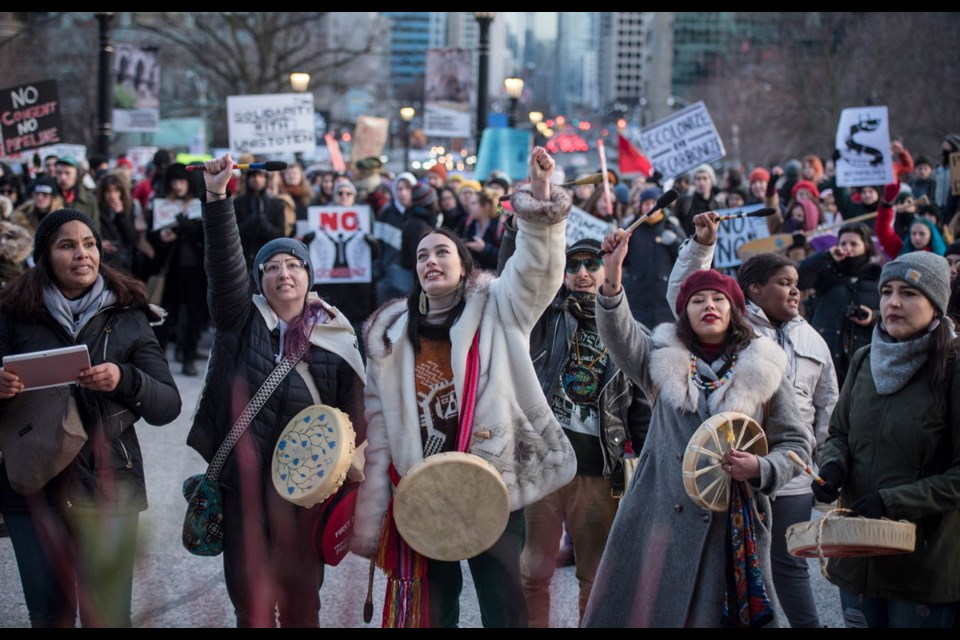A grassroots campaign organized on social media, not large non-governmental organizations, is behind B.C. demonstrations in solidarity with Wet’suwet’en hereditary chiefs, say people on the front lines.
Last week, demonstrators blockaded the Port of Vancouver, the B.C. legislature and a CP Rail yard. They occupied Attorney General David Eby’s constituency office, shut down major intersections and a bridges in Victoria and Vancouver, and picketed B.C. government buildings.
Similar actions are happening across Canada in response to the arrests of demonstrators and a standoff with RCMP at a Wet’suwet’en camp in northern B.C. over Coastal GasLink’s routing of a natural gas pipeline though traditional territory.
Natalie Knight, who helped organize Vancouver events including the port blockade and a rally, said many of the people behind the scenes are from a network of people who met as early as 2010 while protesting the Vancouver Olympics.
“A significant number of us have been involved in organizing around anti-capitalism, migrant justice, Indigenous sovereignty, low-income housing, homelessness and the Downtown Eastside,” she said. “A second layer is youth who have been activated through climate justice stuff in the past year.”
That includes youth inspired by Greta Thunberg’s Fridays for Future movement, which brought climate strikes to B.C.
“There’s always NGOs but they are not — and I can’t stress this enough — they are not involved in on-the-ground organizing,” Knight said. “It’s truly grassroots. It’s people who have community connections to events, who have been up to Unist’ot’en [camp], who are involved in other similar struggles in the city.”
Much of the organizing is done on Facebook, but people are also connecting on Instagram, particularly through the @voicesfrontlines account, Knight said. The demonstrators are alerting each other to action using the hashtags #WetsuwetenStrong, #ShutdownCanada and #AllEyesOnWetsuweten.
Ivan Drury of the Red Braid Alliance for Decolonial Socialism said many of the participants have been young Indigenous activists who have become leaders of the movement in Vancouver.
Drury said he met five of them when Red Braid participated in the CP Rail blockade on Thursday night. They had been at the occupation of Eby’s office earlier that day, and two told him that their first act of protest had been a blockade on Granville Street Bridge on Wednesday, he said.
“What maybe people might miss is that there’s a spontaneous movement,” Drury said. “If people just put a shingle out, there’s going to be hundreds of people who show up.”
Drury said he hasn’t seen such diverse participation in political action since protests against the Iraq war in 2003.
“What’s inspiring about this movement for me — as I’ve been organizing for more than 20 years — is to see the mass character of it,” he said. “It’s really not reducible to a group.”
Atiya Jaffar, a campaign organizer with 350.org Canada, said the climate change-fighting NGO’s participation has been limited to using its “megaphone” to amplify voices from the front line of actions across Canada.
She said 350.org has been directing its supporters toward grassroots organizing efforts — many of them recruiting participants through social media and text message — and sharing the Unist’ot’en supporter tool kit, which Knight described as foundational to the movement.
“350’s contributions are a tiny drop in the ocean of resistance led by grassroots movements in solidarity with Wet’suwet’en land defenders,” Jaffar said.
David Tindall, a sociology professor at the University of B.C. who researches environmental movements, said the action has mostly been a mixture of organized events and spontaneous grassroots mobilization through social media.
Tindall said he doesn’t believe the current action will quickly fade away like some other movements do.
“Sometimes there’s some kind of compromise between protesters and authorities, and they meet in the middle somewhere, or the protest kind of just wanes, kind of winds down and people lose interest,” he said.
“But I think that it’s different a little bit because there are some moral and legal issues. On Wet’suwet’en territory, the sort of central players are the hereditary chiefs who are trying to assert their rights and title on their traditional territories. They’re not going to likely be willing to compromise and say: ‘OK, well, we’ll take half our rights and half of our title and meet you in the middle somewhere.’”
The project is supported by five of six elected Wet’suwet’en band councils, representing a quarter of the B.C. First Nations bands that have signed letters of support for the pipeline in exchange for financial, employment and training benefits. The company has promised $1 billion in benefits to First Nations along the 670-km route.



